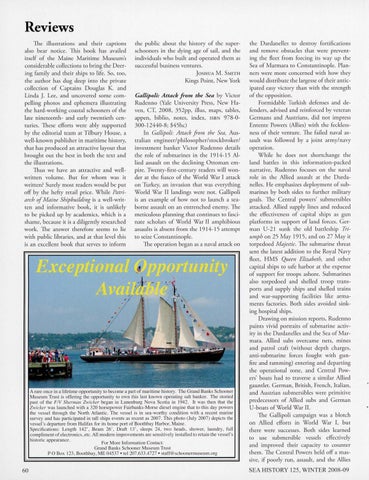Reviews The illustrations and their captions also bear notice. 1his book has avai led itself of the Maine Maritime Museum's considerable collections to bring the D eering family and their ships to life. So, too, the author has dug deep into the private collection of Captains Douglas K. and Linda ]. Lee, and uncovered some compelling photos and ephemera illustrating the hard-working coastal schooners of the late nineteenth- and early twentieth centuries. These efforts were ably supported by the editorial team at Tilbury House, a well-known publisher in maritim e history, that has produced an attractive layo ut that brought out the best in both the text and the illustrations. Thus we have an attractive and wellwritten volume. Bur for whom was it written? Surely most readers would be put off by the hefty retail price. While Patriarch of Maine Shipbuilding is a well-written and informative book, it is unlikely to be picked up by academics, which is a shame, because it is a diligently researched work. The answer therefore seems to lie with public libraries, and at that level this is an excellent book that serves to inform
the public about the history of the superschooners in the dying age of sail, and the individuals who built and operated them as successful business ventures. JosHuA M. SMITH
Kings Point, New York
Gallipoli: Attack from the Sea by Victor Rudenno (Yale University Press, New H aven, CT, 2008, 352pp, illus, maps, tables, appen, biblio, notes, index, ISBN 978-0300-12440-8; $45 hc) In Gallipoli: Attack from the Sea, Australian engineer/philoso pher/stockbroker/ investment banker Victor Rudenno details the role of submarines in the 19 14- 15 Allied assault on the declining Ottoman empire.Twenty-first-century readers will wonder at the fiasco of the World War I attack on Turkey, an invasion that was everything World War II landings were not. Gallipoli is an example of how not to launch a seaborne assault on an entrenched enemy. The meticulo us planning that continues to fascinate scholars of World War II amphibious assaults is absent from the 191 4- 15 attempt to seize Constantinople. The operation began as a naval attack on
A rare once in a lifetime opportunity to become a part of maritime hi story. The Grand Banks Schooner Museum Trust is offering the opportunity to own thi s last known operating sa lt banker. The storied past of the FIV Sherman Zwicker began in Lunenburg Nova Scotia in 1942. It was then that the Zw icker was launched with a 320 horsepower Fairbanks-Morse diesel engine that to this day powers the vesse l through the North Atlanti c. The vessel is in sea-worthy condition with a recent marine survey and has parti cipated in tall ships events as recent as 2007. This photo (Jul y 2007) depicts the vesse l's departure from Hali fax for its home port of Boothbay Harbor, Maine. Spec ifications: Length 142', Bea m 26', Draft 13', sleeps 24, two heads, shower, laundry, fu ll compliment of electronics, etc . All modern improveme nts are sensitively installed to retain the vessel's hi stori c appearance. For More Information Contact: Grand Banks Schooner Mu seum Tru st P 0 Box 123, Boothbay, ME 045 37 •te l 207.633.4727 • staff@schoonennu seum.org
60
the Dardanelles to destroy fortifications and remove obstacles that were preventing the fleet from forcing its way up the Sea of Marmara to Constantinople. Planners were more concerned with how they wo uld distribute the largesse of their anticipated easy victory than with the strength of the opposition. Formidable Turkish defenses and defenders, advised and rein forced by veteran Germans and Austrians, did not impress Entente Powers (Allies) with the fecklessness of their venture. The failed naval assault was followed by a joint army/navy operation. W hile he does not shortchange the land battles in this information-packed narrative, Rudenno focuses on the naval role in the Allied assault at the Dardanelles. H e emphasizes deployment of submarines by both sides to further military goals. The Central powers' submersibles attacked. Allied supply lines and reduced the effectiveness of capital ships as gun platforms in support of land forces. German U-2 1 sunk the old battleship Triumph on 25 May 1915, and on 27 May it torpedoed Majestic. The submarine threat sent the latest addition to the Royal Navy fleet, HMS Queen Elizabeth, and other capital ships to safe harbor at the expense of support for troops ashore. Submarines also torpedoed and shelled troop transports and supply ships and shelled trains and war-supporting facilities like armaments factories. Both sides avoided sinking hospital ships. Drawing on mission reports, Rudenno paints vivid portraits of submarine activity in the Dardanelles and the Sea of Marm ara. Allied subs overcam e nets, mines and patrol craft (witho ut depth charges, anti-submarine forces fought with gunfire and ramming) entering and departing the operational zo ne, and Central Powers' boats had to traverse a similar Allied gauntlet. German, British , French, Italian, and Austrian submersibles were primitive predecessors of Allied subs and German U-boats of World War II. The Gallipoli campaign was a blotch on Allied efforts in World War I, but there were successes . Both sides learned to use submersible vessels effectively and improved their capacity to counter them. The Central Powers held off a massive, if poorly run , assault, and the Allies
SEA HISTORY 125, WINTER 2008-09
